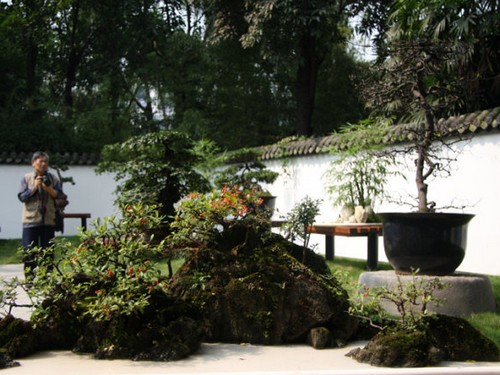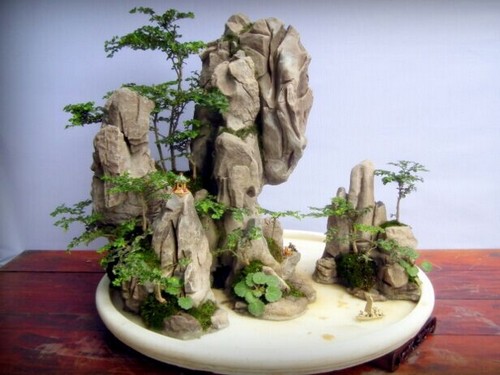Historical Origin of Sichuan Style Bonsai Art
With a suitable climate, dense vegetation, rich products and outstanding people, Sichuan has been known as the "land of abundance" since ancient times and has the conditions for the development of bonsai. Sichuan bonsai is a bonsai art school named after its region. It originated from the five dynasties and has a long history.

Sichuan bonsai is roughly divided into two artistic styles of western Sichuan and eastern Sichuan, with Chengdu and Chongqing as the center, among which the tree stump bonsai represented by Chengdu can best reflect the characteristics of Sichuan bonsai. Chengdu stump bonsai pay attention to freehand brushwork, elegant and beautiful, with rich and colorful plant materials to win, unique artistic style, recognized by the garden community as one of the eight major schools of bonsai in China-Sichuan bonsai, famous at home and abroad.
The long history and superior natural conditions have promoted the continuous development of bonsai art, while the resplendent Ba-Shu culture and local unique rich natural materials have given birth to today's unique Sichuan bonsai art.
The land of Bashu has a profound artistic context.
"Bashan Shushui, flood and drought from people", as early as the Han Dynasty, Chengdu has been the southwest cultural center and economic center. From Chen Ziang's sigh that "no one has ever come before, no one has come since", Xue Tao's absolute view of "looking at the river flow, looking up the river tower, looking at the river flow through the ages", and the pride of the three Soviet dynasties, to the chanting of the scenery of Shu by modern poets Guo Moruo and Ba Jin, we can see the aura of the outstanding people in Shu.
In the early Tang Dynasty, Sijie, Li Bai, du Fu, Wang Wei, Jia Dao and Li Shangyin settled in Shu for a long time and created many well-known works. on the one hand, these works are the quintessence absorbed from Ba-Shu scenery, on the other hand, it is integrated into the author's personal artistic success, thus constantly injecting fresh blood into the developing Ba-Shu culture and forming rich and colorful art forms.
The Great Sheng ci painting Records once recorded the grand event when painters gathered in Chengdu, saying that "there are as many Tang paintings in the world as Chengdu." From the painters born and raised here, Huang Kui and his son, Shike to Wu Daozi, Li Sixun, Zuoquan, and modern masters Zhang Daqian and Xu Beihong, who lived in Shu, they not only continuously promoted the development of Ba-Shu culture and art, but also profoundly influenced the style orientation of bonsai art.
If poise and atmosphere are taken from the style of poets and painters, then elegance and variety come from the inspiration given by religious art. As an important part of history and culture, religious thought has played a key role in the development of Sichuan bonsai. Taoism, as the native religion of our country, has developed unprecedentedly since the Northern and Southern dynasties, especially in the southwest, together with the Buddhism introduced from Tianzhu, it has formed a pattern of "beautiful mountains and frequent temples". To some extent, the prosperity of religion determines the ideological connotation of artistic creation. Sichuan Bonsai School absorbs more local religious ideas and embodies the elegant and simple Taoist style.
Time: 2019-06-04 Click:
- Prev

Sichuan style bonsai reflects the elegant urban temperament of Chengdu.
Bonsai is a bright spot in Chengdu's gardens and museums. As a characteristic intangible cultural heritage of Chengdu, Sichuan style bonsai is one of the four major schools of Chinese traditional bonsai. From the Eastern Han Dynasty, bonsai artists in Shu began to explore how to condense the wonders of landscape and nature into a small basin. To the five dynasties
- Next

The style, layout and styling characteristics of Sichuan style Bonsai Art
The long history and superior natural conditions have promoted the continuous development of bonsai art, while the resplendent Ba-Shu culture and local unique rich natural materials have given birth to today's unique Sichuan bonsai art. Pursue the pictorial style of nature, form and spirit: Sichuan style bonsai comes from life and is higher than life.
Related
- Fuxing push coffee new agricultural production and marketing class: lack of small-scale processing plants
- Jujube rice field leisure farm deep ploughing Yilan for five years to create a space for organic food and play
- Nongyu Farm-A trial of organic papaya for brave women with advanced technology
- Four points for attention in the prevention and control of diseases and insect pests of edible fungi
- How to add nutrient solution to Edible Fungi
- Is there any good way to control edible fungus mites?
- Open Inoculation Technology of Edible Fungi
- Is there any clever way to use fertilizer for edible fungus in winter?
- What agents are used to kill the pathogens of edible fungi in the mushroom shed?
- Rapid drying of Edible Fungi

